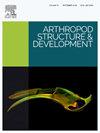足足纲甲壳类介形虫肢的发育与形态研究进展
IF 1.3
3区 农林科学
Q2 ENTOMOLOGY
引用次数: 0
摘要
介形类是微小的双壳类甲壳类动物,几乎在所有水生生态系统中都有分布。它们大量的化石记录,可以追溯到奥陶纪,证明了它们非凡的成功,部分原因是它们的钙质甲壳——一种坚硬的双壳,可以将身体的其他部分包裹起来,以抵御不利的环境条件。然而,甲壳,以及对四肢适应甲壳的要求,导致了四肢数量的减少,这反过来又表明了从一种著名的甲壳类肢体减少的证据。因此,介形虫肢体的特征和同构性有限,阻碍了我们对其进化的理解。对个体发育的研究可以为介形虫肢体的进化提供更多的见解。例如,成虫的触角至少有四条发育途径,这对分类学分类和系统发育分析具有重要意义。个体发生数据还可以识别可能的半胚性和非胚性特征,从而测试系统发育和分类框架。本文以现存的两个亚纲中最大的足足类为研究对象,探讨了在个体发育过程中对肢体发育的研究如何为该类群的进化提供见解。本文章由计算机程序翻译,如有差异,请以英文原文为准。
Development and morphology of podocopan ostracod limbs (Crustacea) – A review
Ostracods are tiny bivalved crustaceans, which have colonised almost all aquatic ecosystems. Their extensive fossil record, stretching back to the Ordovician, attests to their remarkable success, in part due to their calcitic carapace - a hard bivalved shell that can enclose the rest of the body for protection against unfavourable environmental conditions. However, the carapace, and the requirement for the limbs to fit within it, has resulted in a reduced number of limbs, which in turn show evidence of reduction from a biramous crustacean limb. Consequently, ostracod limbs are characterized by limited features and homoeomorphy, hindering our understanding of their evolution. Studies of ontogenetic development can offer additional insights into how ostracod limbs have evolved. For instance, there are at least four developmental pathways to a seven-segmented antennule in adults, which is significant for taxonomic classifications and phylogenetic analyses. Ontogenetic data can also identify possible plesiomorphic and apomorphic characters for the group, thereby testing phylogenetic and taxonomic frameworks. This review focuses on the Podocopa, the largest of the two extant subclasses, and explores how studying limb development during ontogeny can provide insights into the evolution of the group.
求助全文
通过发布文献求助,成功后即可免费获取论文全文。
去求助
来源期刊
CiteScore
3.50
自引率
10.00%
发文量
54
审稿时长
60 days
期刊介绍:
Arthropod Structure & Development is a Journal of Arthropod Structural Biology, Development, and Functional Morphology; it considers manuscripts that deal with micro- and neuroanatomy, development, biomechanics, organogenesis in particular under comparative and evolutionary aspects but not merely taxonomic papers. The aim of the journal is to publish papers in the areas of functional and comparative anatomy and development, with an emphasis on the role of cellular organization in organ function. The journal will also publish papers on organogenisis, embryonic and postembryonic development, and organ or tissue regeneration and repair. Manuscripts dealing with comparative and evolutionary aspects of microanatomy and development are encouraged.

 求助内容:
求助内容: 应助结果提醒方式:
应助结果提醒方式:


